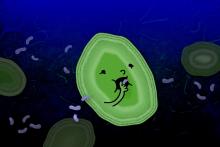One of the smallest and mightiest organisms on the planet is a plant-like bacterium known to marine biologists as Prochlorococcus. The green-tinted microbe measures less than a micron across, and its populations suffuse through the upper layers of the ocean, where a single teaspoon of seawater can hold millions of the tiny organisms.
Prochlorococcus grows through photosynthesis, using sunlight to convert the atmosphere’s carbon dioxide into organic carbon molecules. The microbe is responsible for 5 percent of the world’s photosynthesizing activity, and scientists have assumed that photosynthesis is the microbe’s go-to strategy for acquiring the carbon it needs to grow.
But a new MIT study in Nature Microbiology today has found that Prochlorococcus relies on another carbon-feeding strategy, more than previously thought.
Organisms that use a mix of strategies to provide carbon are known as mixotrophs. Most marine plankton are mixotrophs. And while Prochlorococcus is known to occasionally dabble in mixotrophy, scientists have assumed the microbe primarily lives a phototrophic lifestyle.



